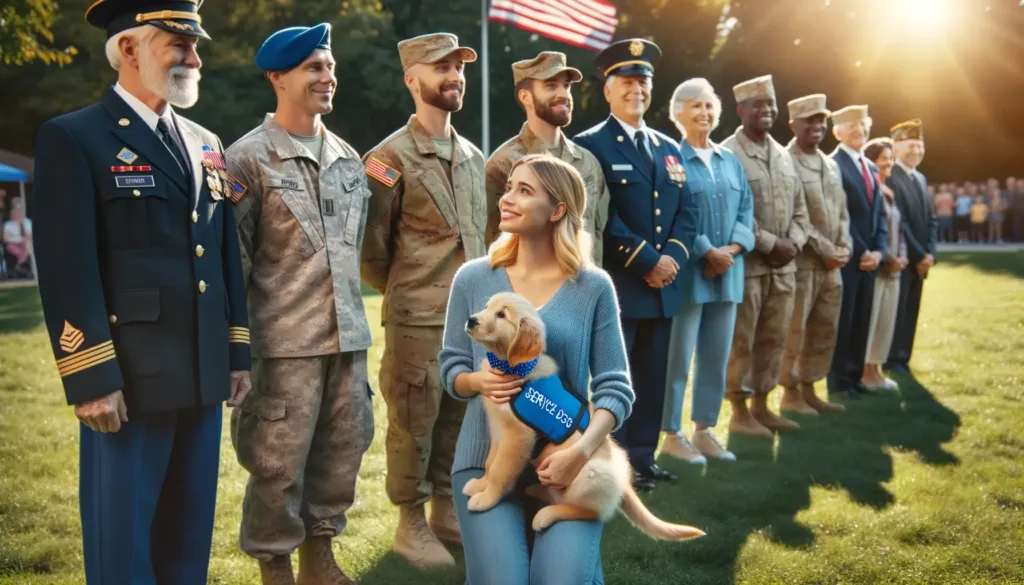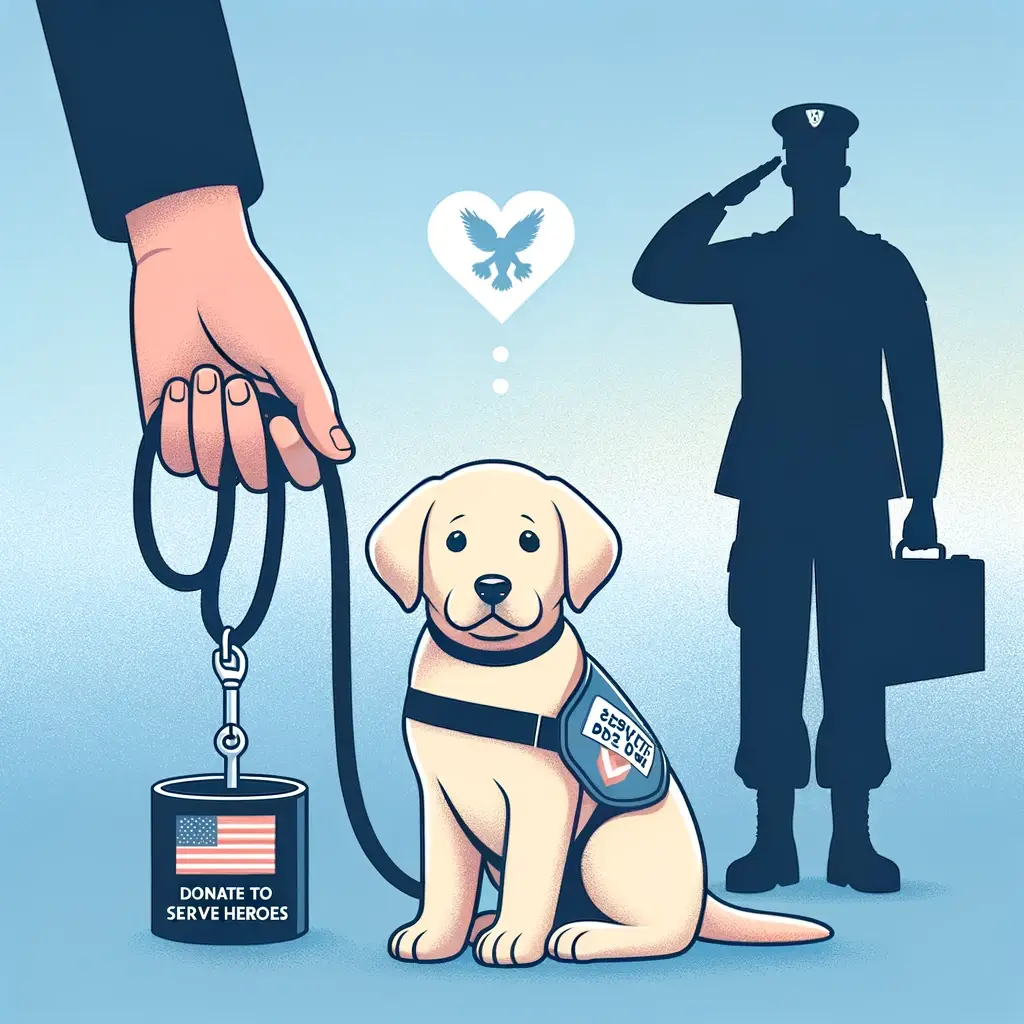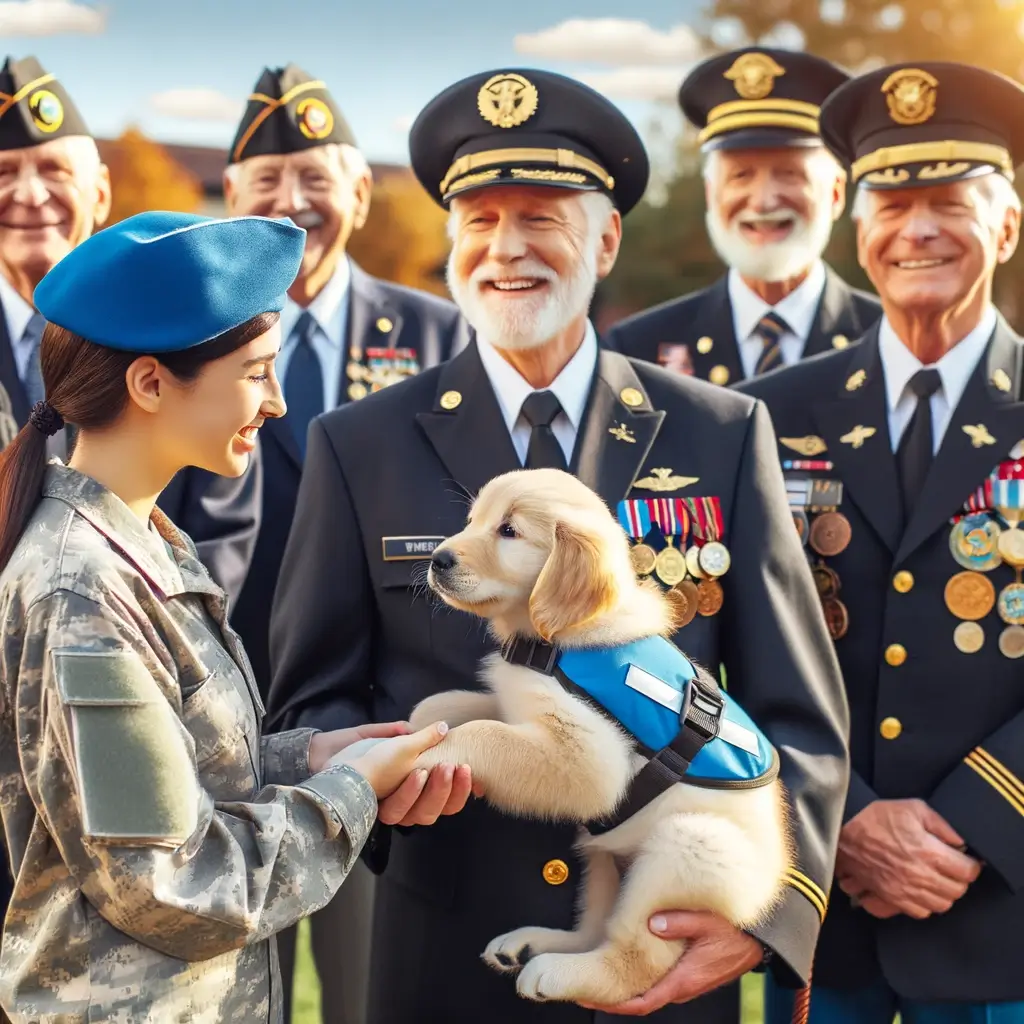Many veterans returning home from service struggle with physical injuries, PTSD, and other challenges. Service dogs can provide life-changing help for these former warriors. By donating your dog to a reputable training program, you can give your pup a new purpose while also transforming a veteran’s life. This comprehensive guide will cover everything you need to know about service dogs and how to donate your K9 to become a four-legged hero.

What Do Service Dogs Do?
Service dogs assist people with disabilities in their day-to-day lives. Some key responsibilities service dogs can perform include:
- Retrieving items like phones, keys, or packages
- Opening and closing doors, cabinets, refrigerators
- Turning lights on and off by flipping switches
- Alerting handlers to important sounds like alarms, timers, and emergency vehicles
- Guiding the blind safely around obstacles and through spaces
- Providing stability support and forward momentum for mobility issues
- Interrupting anxiety attacks or panic episodes by distraction
- Waking handlers from nightmares and flashbacks gently
- Reminding handlers to take necessary medication at proper times
For veterans specifically, service dogs can provide critical emotional support and motivation to get through each day. Tasks like waking them at a certain hour, turning on lights to ease anxiety, and interrupting negative thoughts are invaluable for former warriors suffering from PTSD, depression, and anxiety. The simple act of petting a dog releases oxytocin and reduces stress. With a service dog’s loving assistance, veterans can gain the courage, hope, and dignity they deserve to heal and live fuller lives. Beyond performing trained tasks, these dogs become constant companions – a loyal battle buddy, confidant, and reason to get out of bed every morning.
According to the VA, between 11-20% of veterans who served in Iraq and Afghanistan suffer from PTSD. Around 12% have service-connected disabilities. For these men and women, service dogs can literally save and change lives by reducing substance abuse, easing social reintegration, lowering suicidal thoughts, and improving overall mental health. With a service dog’s unwavering support, veterans gain the strength to reduce medication, attend school or work regularly, participate in hobbies, and reconnect with family. Their dog motivates them to take charge of their health and wellbeing.

Requirements for Donated Service Dogs
If you’re considering donating your dog to a service dog training program, there are certain requirements the canine must meet:
- Age: Most programs want puppies or young adults under 2 years old for easier training. However, some may accept older dogs on a case-by-case basis depending on prior training and health. Usually programs want at least a 10 year working life for their service dogs to make the investment in training worthwhile.
- Size: Service dogs typically range from 40-100 lbs. Larger breeds like retrievers, shepherds, and poodles are frequently chosen because they can perform mobility tasks and keep up with an active handler. Very small dogs under 15 lbs would not be suitable.
- Health: Excellent physical health is imperative, with hip/elbow checks confirming sound structure and joints. Dogs must be up-to-date on all vaccines and on flea/tick preventatives. Any major health issues like heart conditions, allergies, or diet sensitivities may disqualify a dog. Good eyesight and hearing is key too.
- Temperament: Calm, friendly, eager to please. Lacking aggression or territorial instincts. Confident in all public places with excellent situational awareness. Unfazed by crowds, noises, traffic, or distractions. Nervous or anxious tendencies are dealbreakers.
- Training: Must have basic obedience skills mastered – sit, stay, come, heel, loose leash walking. Manners and public access experience a plus. Eagerness for learning, toys, and food motivate best service dogs.
- Time Commitment: Expect to fully commit your dog to the training program for a period of 12-24 months until graduation. This requires handing your dog over to the program and not being involved in the hands-on training process.
The right foundational traits are critical, as service dogs perform skilled, meaningful work daily. They must be comfortable interacting with strangers in unpredictable settings. Not all dogs are cut out for the rigorous demands and high standards of service work. Only a small percentage of candidate dogs graduate fully-fledged service dog programs.
Finding an Accredited Service Dog Organization
Thoroughly research potential organizations before committing your dog for training. Avoid any programs that promise to register or certify your pet dog as a service animal in exchange for a fee. There is no official national certification process for service animals. Here are key traits to look for in identifying a reputable nonprofit training program:
- Accredited Member of Assistance Dogs International (ADI), International Guide Dog Federation (IGDF), or a similar respected accrediting body. This ensures high standards in training methods, dog welfare, ethics and graduate success.
- Proven Track Record of successfully training and placing service dogs with veterans and others with disabilities. Look for client testimonials and program data on graduation rates.
- Positive Reinforcement Training philosophy using rewards-based methods to motivate dogs. Avoid any programs utilizing punishment, corrections, or aversives that could harm trust and rapport.
- Transparency & Education: Provides full visibility into training process, facility, practices, and staff. Offers public education on service dogs. No secrets!
- Nonprofit Status: All-volunteer staff working passionately for the cause over profits. Legitimate programs operate as nonprofits and rely on donations.
- Free of Charge: Covers all costs related to intake, veterinary care, training, certification, equipment, and placement at no cost to you. Beware any nonprofits asking for “sponsorship” fees.

Organizations that meet all of the above criteria demonstrate legitimate dedication to serving veterans through life-changing partnerships with carefully trained service dogs. They believe in giving back.
Recommended Programs
Some highly-regarded nonprofits with excellent track records of providing service dogs for veterans include:
- Paws for Veterans – Hampton, VA
- Paws of War – Nesconset, NY
- Patriotic Service Dog Foundation – Smithtown, NY
- Heroes K9 Rescue – Houston, TX
| Program | Accredited By | Placed Over ## Vets | Location |
|---|---|---|---|
| Paws for Veterans | ADI | 500+ | Hampton, VA |
| Paws of War | ADI | 400+ | Nesconset, NY |
| Patriotic SD Found. | ADI | 300+ | Smithtown, NY |
| Heroes K9 Rescue | ADI | 250+ | Houston, TX |
The Service Dog Donation Process
Once you thoroughly vet and select an accredited program, here’s an overview of the typical donation process:
- Application: Complete intake forms providing background info on your dog – breed, age, training, temperament, health records, etc. This helps evaluate candidate suitability.
- Evaluation: Program staff will meet your dog for standardized behavioral and medical assessments. They will test temperament in public settings and with unusual stimuli to identify any concerns.
- Training: After acceptance, your dog will train full-time with experienced professionals for 12-24 months. Expect full separation during this time. Training occurs in progressive phases advancing obedience, tasks, and public access skills.
- Certification: Your donated dog must pass rigorous public access and skills testing to officially certify as a service dog team. Programs often use tests designed by Assistance Dogs International.
- Matching: The certified graduate gets carefully matched with a veteran based on personality, lifestyle and needs. Compatibility is critical for team bonding.
- Placement: After a period of introduction and bonding, your former pet transitions full-time to their veteran’s home to begin their life of service!
- Follow-Up: The program provides follow-up for the life of the working team. You’ll receive periodic updates on your dog’s progress and the difference they’re making.
Not all donated dogs complete the full demanding program. But they still contribute to life-changing service dog training by practicing skills, socializing trainees, and more.
Considerations Before Donating Your Dog
- Ensure your dog has the ideal temperament for extensive training around distractions and public access work. Nervous, anxious, fearful, or reactive dogs are likely not suitable candidates. Meet the needs of such dogs in other ways.
- Prepare yourself for an extended separation of over one year during your dog’s training. This can be emotional, but it’s for an incredibly meaningful cause! Seek support from family/friends.
- There’s no guarantee that your donated dog will successfully graduate the full program and be placed as a working service dog. The standards are stringent for good reason. But donations are never wasted!
- Remember the profound purpose and joy your dog will experience in a life of service. They’ll live with meaning, dignity and the inner fulfillment of helping someone in need.
- Lean on the guidance of the service dog organization you’ve chosen throughout the process. Communicate openly about any questions or concerns. Trust their expertise.
The Rewarding Life of a Service Dog
Once they graduate and get placed with a veteran partner, service dogs embark on a working life of significant responsibility and challenge. But the days are deeply rewarding for both the dog and the veteran they nobly assist.
A typical day in the life of a veteran’s service dog may include:
- Morning Routine: Wake up their veteran with kisses and cuddles at a set alarm time. Help get them motivated for the day. Retrieve medications and provide tactile stimulation.
- Travel: Confidently guide and stabilize their person on public transportation like buses, trains, or airplanes. Ease anxiety in crowds. Interrupt panic attacks.
- Work/School: Quietly rest or provide distraction during classes, meetings, or other obligations. Retrieve dropped items.
- Public Access: Perform trained skills like opening doors, turning on lights, retrieving items from shelves or the fridge. All while ignoring distractions and remaining professional.
- At Home: Help with chores like laundry. Alert to important sounds. Provide calming pressure therapy. Give affection and comfort after a rough day.
- Evenings: Notice and respond to signs of nightmares, panic attacks, or suicidal thoughts to keep their person safe. Provide a soothing presence.
At the end of each day, service dogs feel fulfilled knowing they served an important purpose and possibly saved a life. They sleep soundly next to their beloved veteran knowing they’re making an immeasurable difference. The mental stimulation, physical activity, and close bonding keep these dogs happy and healthy too.
By selflessly donating your dog to veteran service training, you make all of this life-changing work possible. You take a chance that your beloved companion will go on to give another veteran their health, freedom and confidence back. What an incredible, compassionate gift!
Donate Your Dog to Change Lives
The decision to donate your dog to serve veterans requires careful thought and preparation. Do your research to find an accredited service dog training program that aligns with your values. Assess whether your dog has the ideal temperament and foundation to meet the demands. And get ready for an emotional but rewarding journey that could transform your dog into a literal lifesaver for a veteran in need.
When done right, donating your canine companion to become a service dog grants them a deeply fulfilling new purpose. Just as importantly, it gives a veteran their dignity, confidence, independence and vital emotional support back. By embarking on this journey together, you and your dog could change the world for the better, two lives forever transformed.
Hi, I’m John and I love dogs. Ever since I was a kid, I always wanted to have a furry friend by my side. I grew up with a golden retriever named Max, who taught me a lot about loyalty, friendship, and fun. He was my best buddy for 12 years, and I miss him every day.
